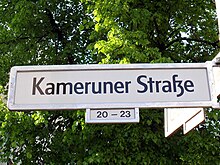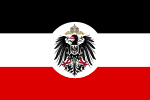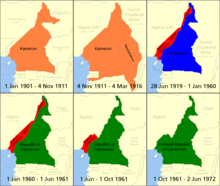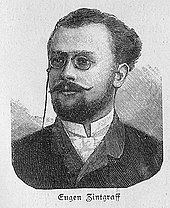Cameroon (German colony)
|
Cameroon (protected area) |
|||||
|---|---|---|---|---|---|
|
|||||
| Capital : | Berlin , German Empire | ||||
| Administrative headquarters: | 1884–1901: Duala 1901–1915: Buea 1915–1916 Jaunde |
||||
| Administrative organization: | 16 districts, 1–2 residences, 2 residences |
||||
| Head of the colony: | 1884/88: Kaiser Wilhelm I. 1888: Kaiser Friedrich III. 1888/99: Kaiser Wilhelm II. |
||||
| Colony Governor: | List of governors | ||||
| Residents: | Old Cameroon: 2,600,000, New Cameroon: approx. 2,000,000, of which Europeans: 1897: 253 (181 Germans), 1912: 1900 (1,000 Germans) |
||||
| Currency: | Gold mark | ||||
| Takeover: | 1884-1916 | ||||
| Today's areas: |
Cameroon ; eastern edge of Nigeria New Cameroon : parts of Gabon , the Republic of the Congo , the Central African Republic and the Republic of Chad |
||||
Cameroon was a German colony (also a protected area ) from 1884 to 1919 . The colony initially had an area of 495,000 km², after the annexation of New Cameroon in 1911 it had an area of 790,000 km² and was about 1.3 times the size of the motherland.
With the Versailles Treaty of 1919, Cameroon officially became the property of the League of Nations , which in turn gave the British and French a mandate to administer it. As a result, Cameroon was divided into a British Cameroon and a French Cameroon .
Taking possession
German trading houses had been active in Gabon since 1862 , including the Woermann house in Hamburg , whose agent Emil Schulz also acted as the imperial consul with official powers up to the Cameroon estuary . In 1868 Woermann set up the first German trading post in Douala . On March 19, 1884, Reich Chancellor Bismarck appointed Gustav Nachtigal , Africa researcher and previous German Consul General in Tunis, as Imperial Commissioner for the west coast of Africa, with the task of placing the areas of interest for German trade under German protectorate. This also included the stretch of coast between the Niger Delta and Gabon, especially the part opposite the island of Fernando Poo in the Bay of Biafra .
On July 10, 1884, Reichskommissar Nachtigal, who was coming from Togo , arrived on the SMS Möwe in Duala . After the signing of protection treaties between the German delegation and the most important leaders of the Duálá , Ndumb'a Lobe ( King Bell ) and Ngand'a Kwa ( Akwa ), on July 11th and 12th, 1884 it came to Duala on July 14th Raising of the German flag and declaration of “ patronage ”. The British consul Hewett, who arrived five days later and wanted to take possession of Cameroon for England, had to be content with a formal protest. He was nicknamed "The too late consul".
Clashes between rival Duálá clans were suppressed in December 1884 by crews from Corvettes SMS Bismarck and SMS Olga under the orders of Rear Admiral Eduard von Knorr . The fighting was not primarily directed against German rule, but marked the beginning of the colony's military subjugation with the suppression by the Reichsmarine .
The provisional boundaries of the colony were determined a year later at the Congo Conference (Congo Act) in Berlin. The final course of the border was based on the treaties of May 3, 1885 (with Great Britain), December 24, 1885 (with France), July 27, 1886 (with Great Britain), August 2, 1886 (with Great Britain), April 14, 1893 (with Great Britain), November 15, 1893 (with Great Britain), March 15, 1894 (with France), 1901 and 1902 (with France) and 1908 (with France).
The colony was significantly enlarged again in 1911 in the Morocco-Congo Agreement at the expense of the French colonies in Central Africa ( New Cameroon ). A smaller area in northeast Cameroon, called the duck's bill , was instead incorporated into French Equatorial Africa . The previous area of the German colony was hereinafter referred to as Old Cameroon . The Bakassi Peninsula became part of Cameroon in 1913 through a German-British border agreement .
A German corvette during the bombardment of Hickorytown (today Duala)
Planned symbols for the German colony of Cameroon
In 1914, a coat of arms and a flag were planned for Cameroon, but no longer introduced due to the start of the war.
Submission and “pacification” of the inland
The officers Richard Kund , Hans Tappenbeck and Curt Morgen undertook the first major expeditions into the inland between 1888 and 1891 in the hinterland of the Batanga coast and the researcher Eugen Zintgraff in the grasslands of West Cameroon , where he founded the Baliburg station . Kund and Tappenbeck founded the Jeundo research station in 1889 , the name of which was soon to be remembered as " Yaounde " and from which today's state capital emerged. Until the First World War, it formed the backbone of German rule in central and southeastern Cameroon. On January 31, 1891, Zintgraff and his allies were defeated in the Battle of Mankon ( Bafut , Northwest Cameroon ).
In the summer of 1891, the governorate commissioned Captain Karl von Gravenreuth to subjugate the Kpe (Bakwiri) von Buëa. Gravenreuth's death while storming the place prevented a sustainable “pacification” of the area around the Cameroon Mountain. Only Curt Morgen and Hans Dominik finally broke the resistance against German rule there in 1894. Max von Stetten , who in the same year took command of the newly founded Imperial Protection Force, carried out several military expeditions against the Bakoko on the lower Sanaga in 1895 . In February 1896, after a revolt by several Ewondo and Bane groups against the Yaounde station, Oltwig von Kamptz forced unimpeded traffic between the coast and the station.
The subjugation of the northeast of the colony was also initiated by Hauptmann von Kamptz by storming the Vute residence Ndumba on January 14, 1899 and Tibati on March 11 . He founded the Joko station as a stage stop and base for the further advance northwards . In October 1901 another expedition was sent under Hans Dominik to get in touch with the Islamic principalities of Adamaua . Before Dominik reached the Fulbe states of North Cameroon, the station manager of Joko, Rudolf Cramer von Clausbruch , had already created a fait accompli against the express orders of the governor von Puttkamer and occupied the important centers of Ngaundere and Garua . Dominik defeated the troops of the emir Djubayru von Yola at Miskin-Marua , which opened the way to Lake Chad. The incorporation of the countries of Chad (Mandara, German Bornu and the Kotoko Sultanates) was carried out by Colonel Curt Pavel in 1902 as the commander of the protection force. The border to the British Protectorate of Northern Nigeria was marked in 1903/1904 with the participation of the German lieutenant Arnold Schultze von Yola as far as Lake Chad .
In the years 1904 to 1906 a guerrilla war broke out in northwest Cameroon on the upper reaches of the Cross River and its tributaries, which went down in Cameroon's history under the name Anyang War and Mpawmanku War .
In 1906 and 1910 the two so-called Maka uprisings occurred in the upper Nyong region . The latter could only be put down using methods that were already controversial at the time.
- "Dominik wired from Akonolinga on 17/6/10 ... Only woman acceptance forces quick submission in the case of non-possessed Makkas and fencers know that they may receive the women, so they spare them. Shoot everything else ... Governor's order is based on ignorance of practice ”.
There were repeated “ colonial scandals” during German colonial rule . The symbol of the brutal suppression of local societies at the beginning of the 1890s in the public perception was the "Leist" case, which was also repeatedly discussed in the Reichstag: The explorer Karl von Gravenreuth, in exceeding his competencies, had several women and men as " The Dahomey King Behanzin" Slaves ”, from which he wanted to form an expeditionary force for the development of the north. The administration, presented by Gravenreuth with a fait accompli, included the men in the police force founded in 1891 and used the women in the service of the governorate. Caused by the lower wages compared to the freely recruited soldiers and brutal attacks against women, the Dahomey mutiny broke out in December 1893 . The unrest was suppressed with the use of a gunboat. The then Deputy Governor Heinrich Leist , who was considered to be primarily responsible for the riots due to the degrading corporal punishment of the Dahome women, was dismissed from his service, but ultimately sentenced to what the liberal and left-wing public perceived as too low a punishment.
Infrastructure
Transportation
From the sea, the German colony of Cameroon was mainly developed through the port of Duala. In addition, landing sites developed at Kampo , Kribi , Rio del Rey and Victoria as well as in Muni Bay . Under the German flag, ships of the Bremen-Africa, Hamburg-America and Woermann lines called at Cameroon regularly. The latter line operated a coastal service and a floating dock in Duala .
In the beginning, overland transport was dominated by foot transport. To make this easier and also to enable vehicle traffic, the Germans expanded the road network and created roads. In addition, two railway construction projects were started after 1900: On the one hand the Mittellandbahn from Duala via Bidjoka to the Njong , of which around 131 km were in operation in 1916, and on the other hand the Northern Railway , also known as the Manenguba Railway. 160 km of it were completed. A third rail project in the south of the colony was requested by traders, but did not find sufficient support from the German government. In addition, there were private small railways, such as the WAPV planting railway . The narrow-gauge railway leading from Victoria to Goppo had a length of 31 km. It connected the plantations on the Cameroon Mountain to the coast. Compared to the route networks of the large colonies of German East Africa and South West Africa, the Cameroon rail network looked modest (around 500 route kilometers compared with over 2000 kilometers in construction or operation).
Communications
The first post office in Cameroon was opened on February 1, 1887. In 1911 there were 37 post offices and 11 telegraph companies in Cameroon, which that year carried a little over a million letters and almost 70,000 telegrams. In 1912 a German submarine cable was continued from Monrovia to Togo and Cameroon, so that German cable traffic became independent of the British line. In 1911 and 1912, a coast radio station for wireless telegraphy was built at Duala. Originally, Cameroon was also intended as a possible location for a major transcontinental radio station. This function was eventually taken over by the Kamina radio station in Togo.
economy
overview
Of the three economic forms in the German colonies - trade, plantation and farm economy - a mixed form between the first two was predominant in Cameroon: Initially, trade in local products dominated. The European trading houses, which were already active on the coast of Cameroon before the founding of the colonies, used the market structures found for business with African intermediaries. In the later years of German rule, parts of Cameroon, especially on the Kamerunberg , developed a pronounced plantation economy and a colonial land policy based on this. While the development and exploitation of natural products had initially shaped the new branches of industry, it was now the agricultural cultivation and processing methods as well as the demand for labor that became the determining factor. In addition, the global economic situation became more noticeable. The main export items on the eve of World War I reflect this change: the ivory trade had declined significantly due to overhunting. Palm fruits and palm oil were no longer only purchased from local residents, but also increasingly grown on plantations based on the European model. The same was true of cocoa , which was grown on a large scale before 1900. Rubber , which was initially collected from wild stocks, developed into an internationally popular mass product due to the demand for rubber , which sometimes led to overexploitation . The cultivation of bananas got off to a promising start. Shortly before the First World War, however, Cameroon's imports overall exceeded exports. This was due, among other things, to investments in infrastructure, for example in railway construction, which were still at the beginning when the war broke out in 1914 compared to other German colonies.
Establishments
The following plantations were among the large and medium-sized companies in the Cameroonian plantation economy:
Large farms (10,000 to 18,000 ha ):
- Bimbia planting Woermann
- Cameroon Land and Plantation Society
- Moliwe planting DKG
- West African Planting Society Victoria AG (WAPV)
- West African Planting Society Bibundi AG (WAPB)
Medium-sized companies (5000 to 10,000 ha):
- African Fruit Compagnie GmbH (AFC)
- German rubber company
- Debundscha planting DKG
- Planting Günther, Soppo
- Cameroon rubber Ko. AG
- Meanja AG rubber planting
- Oechelhäuser plantation
- Planting Scipio (from 1906 Idenau planting)
- Plantation Society South Cameroon GmbH
- Syndicate for oil palm culture GmbH
In Cameroon there were several chambers of commerce as non-governmental corporations of private merchants. The Chamber of Commerce for South Cameroon was founded in October 1907 with its seat in Kribi. In 1911 a Chamber of Commerce for Duala and Central Cameroon followed, which was replaced in 1914 by the Association of North and Central Cameroon Merchants.
administration

Julius Freiherr von Soden became the first full governor on July 4, 1885 . He initiated the construction of a government building in Cameroon, for which the Berlin government master builder W. Scharenberg provided the plans. The ensemble of buildings was erected on a hill (the Joss-Platte ) on the left bank of the Cameroon River in the adapted colonial style. For this purpose, trees were cleared on the hilltop and a transport route with a harbor was created. Bricks , iron girders, wood (from Germany) as well as rubble stones and building sand from the region were used as building materials . The two-storey building contained the offices and apartments for the governor and his officials, a little to the side, accessible through a ten-meter-long corridor, was the kitchen building. The construction cost at least 96,000 marks.
Central developments, such as the exercise of colonial violence over the entire territory of Cameroon and the expansion of colonial economic ventures into the interior, only took place under Jesko von Puttkamer (1895–1906), who shaped the colony in an ambivalent way. On the one hand, his term of office was characterized by expanding agriculture on the Cameroon Mountain. In 1901 he had the administrative headquarters of Duala relocated to the healthier Buëa . On the other hand, the colonial administration under Puttkamer was accused of inconsiderate land policy with forced relocations and a considerable degree of brutality, which triggered another scandal.
The local administration consisted of district offices, government and military stations and residences with indirect administration in the Islamic north of the colony. Before the incorporation of Neukamerun, the districts of Rio del Rey , Victoria , Duala , Jabassi , Johann-Albrechts-Höh , Bare , Ossidinge , Bamenda , Kribi , Edéa , Ebolowa , Lomië , Molundu / Jukaduma , Dume , Jaunde and Banjo , as well as the residencies existed Adamaua and German Tschadseeländer . Two further residential districts were created in 1913 in Ngaundere through the partition of Adamaua and in 1914 in Bamun through the separation of the eponymous chiefs from the Bamenda district.
Colonial troops
The German colonial force in not quite conquered Cameroon was 1,900 German of 15 officers and 23 NCOs, the two Askari - companies commanded by 318 men. There were also 150 local police officers. During the advance into the central savannahs and southern Adamawa in 1908, several volunteer recruits from the tribes of the Bali Nyonga and Bamun were added. The Ewondo put riflemen under their own commanders, called nkukuma . By 1914 the number rose to 1550 Askari with 185 German officers. The paramilitary police force (founded in 1891) comprised 1,200 men and 30 officers. Most of the local troops were recruited outside of Cameroon ( Liberia , Togo , Dahomey ), but the Ngumba , Ndu and some other tribes in particular supported the recruitment by the Germans, as they considered this to be less stressful than the dominance of the Fulbe, for example . In the course of the World War the colonial force was expanded to almost 10,000 men.
After the outbreak of World War I , the numerically and materially defeated protection force (mainly due to a great lack of ammunition) was able to stay in Cameroon for two years. Most of the troops crossed the border to the neighboring Spanish Rio Muni area in early February 1916 and were interned at Fernando Póo or in Spain. On February 20, 1916, the last garrison in Mora (North Cameroon) fell into the hands of the British colonial army after they had promised to withdraw freely.
History after German rule


With the Versailles Treaty of 1919, Cameroon officially became the property of the League of Nations , which in turn gave the British and French a mandate to administer it. As a result, Cameroon was divided into a British Cameroon and a French Cameroon .
German colonial revisionism propagated a return of Cameroon to Germany in the interwar period . In 1924, most of the formerly German plantations in British Cameroon were bought back by the previous owners at a London auction. The Reich administration in the person of Edmund Brückner provided support. In the event of a victory in World War II , Cameroon was to be administered by Bernhard Ruberg and merged into a German Central Africa .
After the Second World War, both League of Nations mandates were converted into trustee mandates by the successor organization, the United Nations . On January 1, 1960, after a referendum and the expiry of the UN mandate, French Cameroon gained independence and called itself East Cameroon. The north of the British mandate area voted in a previous referendum to join Nigeria, the southern part decided to join the state of Cameroon. On November 11, 1960, Cameroon became a member of UNESCO .
See also
literature
- Scientific literature
- Albert Gouaffo: Knowledge and Culture Transfer in a Colonial Context: The Example Cameroon - Germany (1884–1919) . Saarbrücker Contributions to Comparative Literature and Cultural Studies Volume 39, 2007, ISBN 3-8260-3754-5 .
- Alexandre Kum'a Ndumbe III. (Ed.): L'Afrique et l'Allemagne de la Colonisation à la Coopération 1884–1986 (Le cas du Cameroun) , Yaoundé, 1986.
- Alexandre Kum'a Ndumbe III. The German Empire in Cameroon. How Germany was able to build up its colonial power in Cameroon, 1840–1910 , Berlin 2008 (numerous other references on the subject in his name article).
- Victor T. LeVine; Roger P. Nye: Historical Dictionary of Cameroon , Metuchen, NJ 1974.
- Stefanie Michels (ed.): La Politique de la mémoire en Allemagne et au Cameroun - actes du colloque à Yaoundé, October 2003 , bilingual: French and English; LIT, Münster 2005, ISBN 3-8258-7836-8 .
- Stefanie Michels (Ed.): Imagined Power contested. Germans and Africans in the Upper Cross River Area of Cameroon 1887–1915 , LIT Verlag, Münster 2004, ISBN 3-8258-6850-8 .
- Thomas Morlang: Askari and Fitafita: “colored” mercenaries in the German colonies. Chr. Links Verlag, Berlin 2008, ISBN 978-3-86153-476-1 .
- John Mukum Mbaku: Culture and customs of Cameroon . Greenwood Press, Westport (Conn.) 2005, ISBN 0-313-33231-2 .
- Engelbert Mveng: Histoire du Cameroun , Paris, 1963.
- Victor Julius Ngoh: Cameroun 1884-1985; cent ans d'histoire , Yaoundé 1990.
- Adalbert Owona: La Naissance du Cameroun 1884–1914 , Paris, 1996.
- Théophile Owona: The Sovereignty and Legitimacy of the State of Cameroon , Munich, tuduv-Verl.Ges, 1991, ISBN 3-88073-385-6 .
- Frederick Quinn: In Search of Salt. Changes in Beti (Cameroon) Society, 1880–1960 , Cameroon Studies, Volume 6, Berghahn Books, New York / Oxford 2006 ISBN 1-84545-006-X .
- Ulrike Schaper: Colonial Negotiations. Jurisdiction, administration and rule in Cameroon 1884–1916 , Campus Verlag, Frankfurt am Main 2012, ISBN 3-593-39639-4 .
- André Tiebel: The emergence of the protection force laws for the German protected areas German East Africa, German South West Africa and Cameroon (1884–1898) . Legal history series, 358. Peter Lang, Frankfurt 2008, ISBN 3-631-57096-1 .
- Popular, colonial-minded literature
There are countless titles in this genre, especially as youth literature that emphasized the exoticism and adventure aspect. Example:
- Heinrich Norden, pseudonym for the doctor and writer Nikolaus Wöll: Between black and white. A German fighting for Cameroon. Hanns Herziger, Leipzig 1939.
Web links
- 1871-1914. The German colony of Cameroon German Historical Museum
- Histoire du Cameroun sur le site de l'ambassade de France au Cameroun (French)
- Histoire du Cameroun - Université de Laval (Canada) (French)
Individual evidence
- ↑ German Embassy Yaounde: 120 years of Yaounde ( Memento of the original from December 24, 2013 in the Internet Archive ) Info: The archive link was automatically inserted and not yet checked. Please check the original and archive link according to the instructions and then remove this notice.
- ↑ a b Cameroon - German colony from 1884 to 1919 , deutsche-schutzgebiete.de
- ↑ Bernd G. Längin : The German Colonies - Schauplätze und Schicksale 1884-1918. Mittler, Hamburg / Berlin / Bonn 2005, ISBN 3-8132-0854-0 , p. 70.
- ^ Horst founder : History of the German colonies. 5th edition, Paderborn: Schöningh / UTB, 2004, p. 101, ISBN 3-506-99415-8 ( preview on Google Books )
- ↑ Old Cameroon , Deutsches Kolonial-Lexikon , Leipzig 1920, Volume 1, p. 37.
- ↑ Protocol regarding the marking of the German-English border between Cameroon and Nigeria from Yola to the Croß River. With eight map sheets attached. Signed in Obokum on April 12, 1913 ( Memento of the original of July 18, 2017 in the Internet Archive ) Info: The archive link was inserted automatically and has not yet been checked. Please check the original and archive link according to the instructions and then remove this notice. (PDF).
- ^ Léon Koungou: Everyone wants Bakassi, in: Le Monde diplomatique , October 10, 2008.
- ↑ Mr. Powder to Governorate in Buea on June 17, 2010; Archives Nationales de Yaoundé, Fonds Allemand FA 1/92, pp. 35–36
- ^ Franz Baltzer : The colonial railways with special consideration of Africa . Berlin 1916. Reprint: Leipzig 2008, pp. 98f., ISBN 978-3-8262-0233-9 ( preview on Google Books ).
- ↑ Carsten Brekenfeld: collection area German colonies - Cameroon. Series of articles in the Deutsche Briefmarken-Revue 02/2013–08/2014 - available online (PDF).
- ^ Cameroon : Verkehr, in the German colonial dictionary of 1920
- ↑ Reinhard Klein-Arendt: “Kamina ruft Nauen!” The radio stations in the German colonies 1904–1918 . 3rd edition, Cologne: Wilhelm Herbst Verlag, 1999, ISBN 3-923925-58-1 .
- ^ Sebastian Conrad: German colonial history. CH Beck, Munich 2008, ISBN 978-3-406-56248-8 , p. 55ff.
- ↑ a b c Kerstin Wilke: "The German Banana." Dissertation, University of Hanover 2004, p. 162 ff., Online version (PDF).
- ^ Cameroon, in: Deutsches Kolonial-Lexikon , Volume 2, Leipzig 1920, pp. 169ff.
- ↑ Chambers of Commerce, in: Deutsches Kolonial-Lexikon , Volume 2, Leipzig 1920, p. 28.
- ^ Otto Sarrazin, Paul Schäfer: The seat of government in Cameroon . In: Centralblatt der Bauverwaltung , November 7, 1885, pp. 453ff.
- ^ Sebastian Conrad: German colonial history. CH Beck, Munich 2008, ISBN 978-3-406-56248-8 , p. 30.
- ^ Section after: Herbert, Erwin; Heath, Ian; Small Wars and Skirmishes 1902-1918; Nottingham 2003; ISBN 978-1-901543-05-6 , p. 139.






















